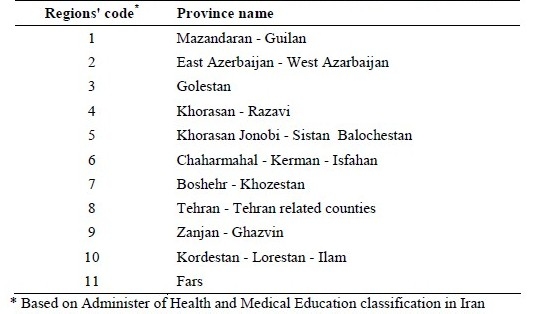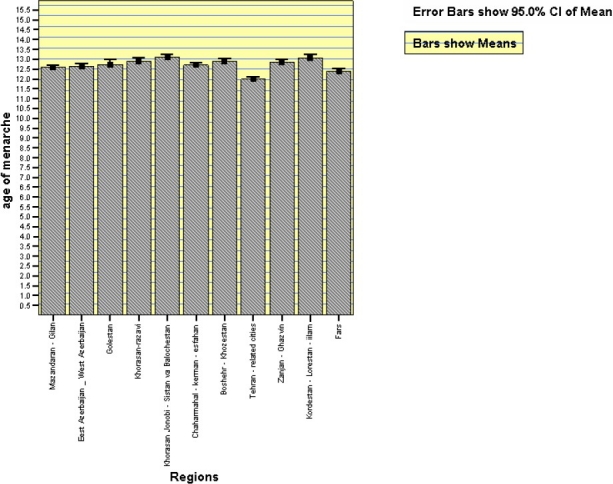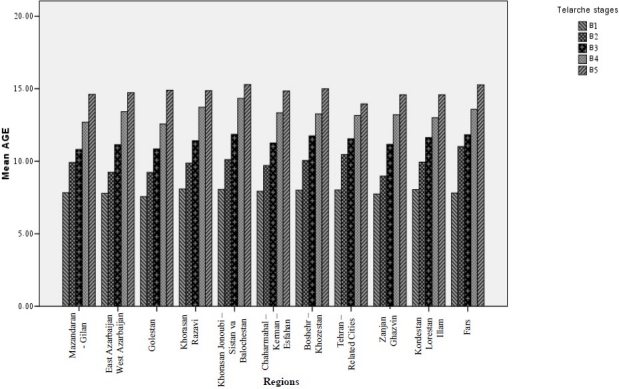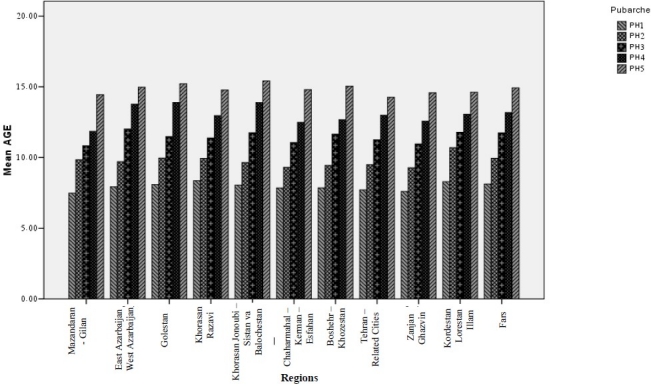Abstract
BACKGROUND:
This study aimed to compare the timing of puberty between various geographic locations and different ethnicities.
METHODS:
This national survey was conducted in 20 provinces in Iran. Healthy Iranian girls were selected from public schools using cluster random sampling. A total number of 30 clusters including 7493 girls, aged 6.0–20 years, were selected. In order to compare different areas, the national classification of the provinces based on climate, ethnicity, geographic locations, and socioeconomic variables were used. Accordingly, there are 11 regions in Iran. Analysis of variance was used to compare the mean ages of menarche, pubarche, and thelarche in different regions.
RESULTS:
Tehranian girls, with 11.99 ± 1.35 years (mean ± SD), had the lowest age of menarche which was statistically significantly. The second region with lowest age at menarche was Fars (12.40 ± 1.27 years). The mean age at breast bud stage (B2) was significantly lower in Ghazvin-Zanjan region (8.97 ± 1.45 years). In Fars region, the mean age at B2 stage of breast development (11.01 ± 1.88 years) was higher than other regions except for Mazendran-Guilan and Tehran-related cities. The mean age at public hair development at Tanner stage 2 (PH2) in Kordestan-Lorestan-Ilam region (10.70 ± 1.23 years) was significantly higher than other regions.
CONCLUSIONS:
We found significant differences in the age of pubertal stages of girls living in various regions with different ethnicity and geographic characteristics. Considering the impact of pubertal age on general health, more studies should be done about the lifestyle and environmental factors affecting the onset of puberty.
Keywords: Puberty, Girls, Living area, Iran
Puberty is a significant event of human growth and maturation; it is associated with marked physiological and psychological changes.1 Despite similar life conditions, noticeable variability is reported in the timing of puberty in developed and developing countries. Ethnicity, environmental conditions, geographic location as well as genetic influence seem to have a role for the timing and progression of puberty.2–7 The timing of puberty may affect the risk of various diseases in adulthood; for instance increased risk of breast cancer, obesity and spontaneous abortion are reported in women with a history of early menarche.8 A national study showed that in Iranian girls, the mean age of breast development at stage 2, pubic hair at stage 2 and menarche was 10.10, 9.83 and 12.55 years, respectively.9 The climate has marked variations in different geographic parts of our vast country, with different ethnicities living in various parts (Persian 51%, Azeri 24%, Gilaki and Mazandarani 8%, Kurd 7%, Arab 3%, Lur 2%, Balooch 2%, Turkman 2%, and other 1%). In this study, we aimed to compare the timing of puberty in a random group of Iranian girls living in various geographic locations with different ethnicities.
Methods
This national survey was conducted in 2006 in 20 provinces in Iran. Healthy Iranian girls were selected from public schools using clustered random sampling. The study protocol was approved by the Ethics Committee of the Ministry of Health and the School Boards. A total number of 30 clusters including 7,493 girls (aged 6–20 years) were selected. Students with a history of acute or chronic diseases or any chronic medication use were excluded. In all subjects, height, weight, and pubertal stages were measured by the same team of trained investigators.
General physicians determined pubertal stages under the supervision of specialists by visual inspection and palpation, using the criteria and definitions described by Marshall and Tanner.10 Accordingly, breast stages 1–5 were determined by both inspection and palpation. breast stage B2 corresponded to the breast bud stage with palpable glandular breast tissue and elevation of the papilla, stage B3 with further enlargement of the breast and areola with no separation of the contours, stage B4 where the areola and papilla form a secondary mound above the level of the breast, and stage B5 was assigned in case of the mature breast with projection of the papilla only. The onset of puberty was measured as the age at breast development at Tanner stage 2 (B2).
Pubic hair stages (PH1–PH5) were also evaluated. Stage PH2 was assigned with the presence of long, slightly pigmented hair (straight or curled). Mean menarcheal age was also documented using status quo and recall methods. Participants were grouped by 1-year age intervals, which extended from the day of their birthday to the day before the next birthday.
For comparison of different areas, we used the national classification of the provinces according to their climate, ethnicity of the population, geographic locations, and socioeconomic variables. Based on this grouping, Iran has 11 regions presented in Appendix 1.
Appendix 1.
Classification of Iranian provinces to regions according to climate, geographic location, ethnicity and socioeconomic status

Statistical analysis
We estimated the mean of the time of men-arche, B2-B5 and PH2-PH5 stages. B2 and PH2 were considered to compare the telarche and pubarche in different regions. Statistical analysis was done using SPSS version 15 (SPSS, Chicago, IL). Analysis of variance (ANOVA) and Post-hoc tests were used to compare the mean ages of menarche, pubarche, and telarche in different regions. The statistical significance was set at p< 0.05.
Results
The mean age at menarche in different regions is presented in Figure 1. Tehran had the lowest mean age of menarche, being 11.99 ± 1.35 years, which was significantly lower than other 10 regions. The second region with lowest age at menarche was Fars (12.40 ± 1.27 years). The mean age at B2 stage of breast development was significantly lower in Ghazvin-Zanjan region (8.97 ± 1.45 years) followed by the region consisting of Khorasan Jonobi and Sistan Balochestan (10.11 ± 1.61 years; p = 0.003), Boshehr-Khouzestan region (10.05 ± 1.21 years; p = 0.01), Tehran-relatd cities (10.46 ± 1.67 years; p < 0.0001), Fars (11.01 ± 1.88 years; p < 0.0001) and Kordestan-Lorestan-Ilam region (9.94 ± 1.25 years; p = 0.02). In Fars region, the mean age at B2 stage of breast development (11.01 ± 1.88 years) was higher than other regions except for Mazendran-Guilan and Tehran-related cities regions. Figure 2 shows the mean age at B1-B5 of breast development in different regions in Iran.
Figure 1.

Mean age (years) at menarche in different regions
Figure 2.

Mean age (years) at various stages of telarche in different regions in Iran
The mean age at PH2 stage of pubarche in Kordestan-Lorestan-Ilam region (10.70 ± 1.23 years) was significantly higher than Khorasan Jonobi-Sistan Balochestan region (p < 0.0001), Boshehr-Khozestan region (p < 0.0001), Tehran-relatd cities (p < 0.0001), Chaharmahal-Kerman-Isfahan region (p < 0.0001), Ghazvin-Zanjan region (p < 0.0001), and Boshehr-Khozestan region (p < 0.0001). The mean age at PH2-PH5 of pubic hair development in different geographic locations of Iran is presented in Figure 3.
Figure 3.

Mean age (years) at various stages of pubarche in different regions in Iran
Discussion
To the best of our knowledge, this is the first study of its kind to compare the pubertal stages in different geographic locations in a country. It should be acknowledged that such comparison is not feasible in many countries with small population and no significant diversity in climate and other geographic characteristics. We found that the mean age of menarche was significantly lower in Tehran than all other regions. Tehran province, including the metropolitan city of Tehran, is located in central part of the country with multiethnic population. Many people migrated to this province as a capital city of Iran. Not only multi-ethnicity but also higher socioeconomic status and more industrialized lifestyle habits in Tehran might be associated with earlier menarche age. In another study the mean age of menarche was 12.68 years in Tehran in 2004.11 In our study conducted 2 years later, this age decreased to 11.99 ± 1.35 years. Decreasing trend of menarche age is observed in many developed and developing countries.12,13 It might be attributed to changes in socioeconomic status of people14 and increasing rate of obesity.12
Ethnicity is documented as a factor that describes some international varieties of puberty age.15,16 In the current study, the mean age at menarche and PH2 was higher in girls with Kurd ethnicity than in other ethnicities. Kurd ethnicity is the third most prevalent ethnicity in Iran after Persian and Azeri ethnicities. It can be suggested that the higher age of puberty in girls of this region might be attributed to their ethnicity as well as the cold climate and their high altitude mountainous region of living.
In addition to ethnicity, the geographic characteristics may influence the age of puberty. In our study, the lowest mean age at B2 was documented in Zanjan-Ghazvin region, with Mediterranean weather and spring rains, and population of Azeri ethnicity. The earlier telarche in this region in comparison to other regions with Azeri population might be attributed to environmental factors. Premature telarche is suggested to be associated with endocrine disrupting chemicals found in pesticides and plastics, with possible estrogenic and androgenic activities.17,18 Further investigations on environmental pollution might be necessary in this regard. The considerably high prevalence of overweight among young Iranian children19 might decrease the age of puberty in the near future.
We should consider these findings under the light of our study limitations. The main limitation of this study was its cross sectional nature, and as a result, casualty cannot be ascertained. In addition, we considered the prominent ethnicity in each region; but some participants might have other ethnicities. Large sample size and population-based methodology were the strengths of our study.
Conclusions
We found significant differences in the age of pubertal stages of girls living in various regions with different ethnicity and geographic characteristics. The lowest age of puberty was documented in the metropolitan Tehran. Considering the impact of pubertal age on general health, more studies should be done about the lifestyle and environmental factors affecting the onset of puberty.
Authors’ Contributions
MEM participated in the design and conducting the study; AR participated in the design and conducting the study and helped to draft the manuscript; RK drafted and edited the manuscript; PM conducted the statistical analyses and helped to draft the manuscript; SS participated in conducting the study; GA participated in the design and conducting the study; HA participated in conducting the study; NP participated in conducting the study; SK in conducting the study; PP helped to draft and edit the manuscript; AS participated in conducting the study. All authors read and approved the final manuscript.
Acknowledgments
This study was conducted as a research project in Tehran University of Medical Sciences, funded as a grant of the Ministry of Health and Medical Education Tehran, IR Iran. The authors are thankful to the large team working with this project in different provinces.
Footnotes
Conflict of Interests Authors have no conflict of interests.
References
- 1.Hosny LA, El Ruby MO, Zaki ME, Aglan MS, Zaki MS, El Gammal MA, et al. Assessment of pubertal development in Egyptian girls. J Pediatr Endocrinol Metab. 2005;18(6):577–84. doi: 10.1515/jpem.2005.18.6.577. [DOI] [PubMed] [Google Scholar]
- 2.Wu T, Mendola P, Buck GM. Ethnic differences in the presence of secondary sex characteristics and menarche among US girls: the Third National Health and Nutrition Examination Survey, 1988-1994. Pediatrics. 2002;110(4):752–7. doi: 10.1542/peds.110.4.752. [DOI] [PubMed] [Google Scholar]
- 3.Rogol AD, Clark PA, Roemmich JN. Growth and pubertal development in children and adolescents: effects of diet and physical activity. Am J Clin Nutr. 2000;72(2 Suppl):521S–528S. doi: 10.1093/ajcn/72.2.521S. [DOI] [PubMed] [Google Scholar]
- 4.Kashani HH, Kavosh MS, Keshteli AH, Montazer M, Rostampour N, Kelishadi R, et al. Age of puberty in a representative sample of Iranian girls. World J Pediatr. 2009;5(2):132–5. doi: 10.1007/s12519-009-0026-1. [DOI] [PubMed] [Google Scholar]
- 5.Juul A, Teilmann G, Scheike T, Hertel NT, Holm K, Laursen EM, et al. Pubertal development in Danish children: comparison of recent European and US data. Int J Androl. 2006;29(1):247–55. doi: 10.1111/j.1365-2605.2005.00556.x. [DOI] [PubMed] [Google Scholar]
- 6.Harlan WR, Harlan EA, Grillo GP. Secondary sex characteristics of girls 12 to 17 years of age: the U.S. Health Examination Survey. J Pediatr. 1980;96(6):1074–8. doi: 10.1016/s0022-3476(80)80647-0. [DOI] [PubMed] [Google Scholar]
- 7.Villarreal SF, Martorell R, Mendoza F. Sexual maturation of Mexican- American adolescents. Am J Hum Biol. 1989;1(1):87–95. doi: 10.1002/ajhb.1310010113. [DOI] [PubMed] [Google Scholar]
- 8.Freedman DS, Khan LK, Serdula MK, Dietz WH, Srinivasan SR, Berenson GS. Relation of age at menarche to race, time period, and anthropometric dimensions: the Bogalusa Heart Study. Pediatrics. 2002;110(4):e43. doi: 10.1542/peds.110.4.e43. [DOI] [PubMed] [Google Scholar]
- 9.Rabbani A, Motlagh M, Mhammad K, Ardalan G, Maftoon F, Shahryari S, et al. Assessment of Pubertal Development in Iranian Girls. Iran J Pediatr. 2010;20(2):160–6. [PMC free article] [PubMed] [Google Scholar]
- 10.Marshall WA, Tanner JM. Variations in pattern of pubertal changes in girls. Arch Dis Child. 1969;44(235):291–303. doi: 10.1136/adc.44.235.291. [DOI] [PMC free article] [PubMed] [Google Scholar]
- 11.Razzaghy-Azar M, Moghimi A, Sadigh N, Montazer M, Golnari P, Zahedi-Shoolami L, et al. Age of puberty in Iranian girls living in Tehran. Ann Hum Biol. 2006;33(5-6):628–33. doi: 10.1080/03014460600909372. [DOI] [PubMed] [Google Scholar]
- 12.Ahmed ML, Ong KK, Dunger DB. Childhood obesity and the timing of puberty. Trends Endocrinol Metab. 2009;20(5):237–42. doi: 10.1016/j.tem.2009.02.004. [DOI] [PubMed] [Google Scholar]
- 13.Castellino N, Bellone S, Rapa A, Vercellotti A, Binotti M, Petri A, et al. Puberty onset in Northern Italy: a random sample of 3597 Italian children. J Endocrinol Invest. 2005;28(7):589–94. doi: 10.1007/BF03347256. [DOI] [PubMed] [Google Scholar]
- 14.Henneberg M, Louw GJ. Average menarcheal age of higher socioeconomic status urban Cape coloured girls assessed by means of status quo and recall methods. Am J Phys Anthropol. 1995;96(1):1–5. doi: 10.1002/ajpa.1330960102. [DOI] [PubMed] [Google Scholar]
- 15.Thomas F, Renaud F, Benefice E, de Meeus T, Guegan JF. International variability of ages at menarche and menopause: patterns and main determinants. Hum Biol. 2001;73(2):271–90. doi: 10.1353/hub.2001.0029. [DOI] [PubMed] [Google Scholar]
- 16.Sampei MA, Novo NF, Juliano Y, Colugnati FA, Sigulem DM. Anthropometry and body composition in ethnic Japanese and Caucasian adolescent girls: considerations on ethnicity and menarche. Int J Obes Relat Metab Disord. 2003;27(9):1114–20. doi: 10.1038/sj.ijo.0802374. [DOI] [PubMed] [Google Scholar]
- 17.Uche-Nwachi E, Odekunle A, Gray J, Bethel T, Burrows Y, Carter J, et al. Mean age of menarche in trinidad and its relationship to body mass index, ethinicity and mothers age of menarche. Online J Biol Sci. 2007;7(2):66–71. [Google Scholar]
- 18.Rogan WJ, Ragan NB. Evidence of effects of environmental chemicals on the endocrine system in children. Pediatrics. 2003;112(1 Pt 2):247–52. [PubMed] [Google Scholar]
- 19.Motlagh ME, Kelishadi R, Amirkhani MA, Ziaoddini H, Dashti M, Aminaee T, et al. Double burden of nutritional disorders in young Iranian children: findings of a nationwide screening survey. Public Health Nutr. 2010:1–6. doi: 10.1017/S1368980010002399. [DOI] [PubMed] [Google Scholar]


